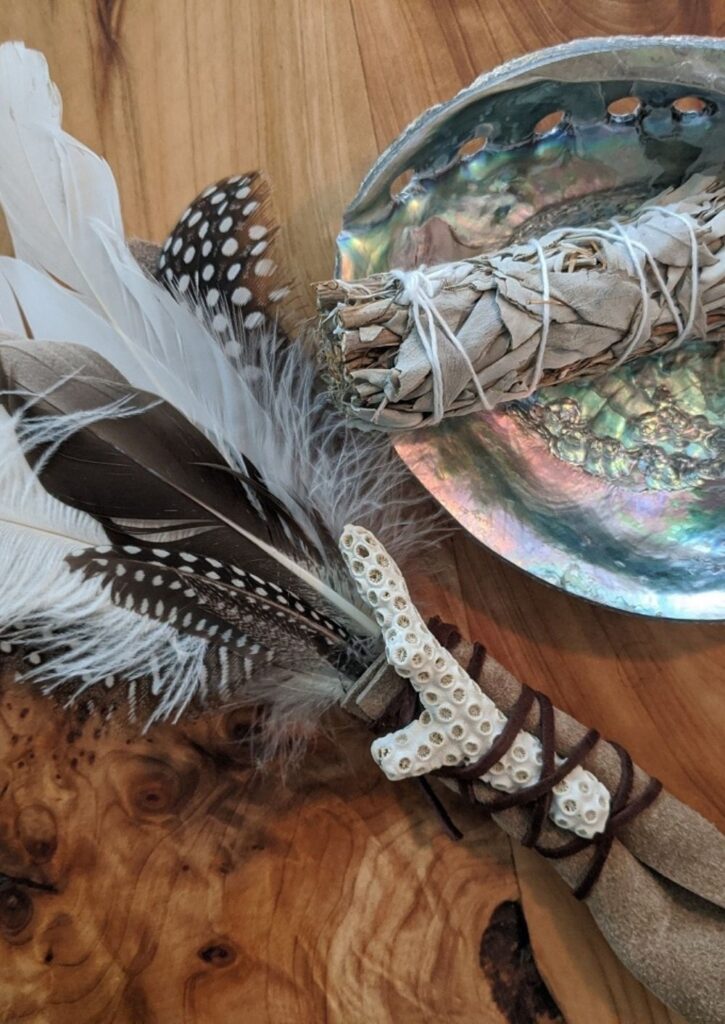I didn’t even know smudging was a thing until a few years ago when I attended an event in Seattle. One of the speakers casually smudged the room before she began her presentation. The whole process took just a couple of minutes, but the dynamics of the group shifted almost immediately. This article explores smudging as an act of self-care.

LivingUpp is a participant in affiliate programs, which means we may earn a small commission from qualifying purchases on links to Amazon and other sites at no additional cost to you.
What is Smudging?
Smudging is the spiritual practice of using smoke to clear the energy of a space.
I’ll be honest, I was skeptical about it at first. I was raised in a Christian home and attended a Christian school, and I was taught that rituals (outside of church anyway) were irreverent, if not downright sinful.
But I’ve since realized that the practice has very little to do with my personal relationship with God.
I now see that grounding self-care practices like smudging aren’t dissonant unless we make them so.
From that perspective, smudging isn’t really much different than lighting a candle or clutching a rosary while saying a prayer.
Rituals of any kind create space to develop deeper spiritual connections, regardless of your religion affiliation. It’s what’s in your heart that matters, and that’s a personal matter between you and your creator.
Origins of Smudging
The burning of dried herbs, sometimes called smudging, is a well-known spiritual cleansing ritual used frequently in Native American purification ceremonies. In some cultures, smudging is thought to drive away negative energy and cleanse personal spaces.
But the practice is not relegated to indigenous communities; it shows up in other spiritual settings as well.
Health Benefits of Smudging
Ceremonial practices aside, you might be wondering if there are any health benefits associated with smudging.
If you’re looking for concrete evidence, you’ll probably be disappointed. The research is scant at best, at least if you’re focused only on outcomes tied to the smoke itself.
The truth is, smudging isn’t just about filling a space with smoke. It goes much deeper and involves a shift in mindset. The space it creates invites the pause and reflection necessary to invite gratitude and deeper spiritual connections. With that in mind, I’m not even sure modern research is relevant.
Here are a few health benefits that have been suggested:
Antimicrobial Properties of Smudging
Antimicrobial properties are probably the most cited health benefit associated with smudging. White sage (Salvia apianahas) has been used throughout history to treat sore throats, coughs, chest colds, and respiratory infections. The antimicrobial properties of the plants typically used in smudging rituals are also thought to guard against airborne bacteria and insects.
Energy Properties of Smudging
From a spiritual standpoint, energy is an an interesting, if not elusive, concept. Whether or not you believe in spiritual energies, some claim that smudging increases energy levels. I actually found the opposite to be true. (Read about my personal experience below.)
Contraindications of Smudging
Individuals with pre-existing lung conditions, such as asthma, should use caution, as inhalation of smoke may exacerbate symptoms. (Note: I have asthma yet haven’t experienced any issues.)
Aside from the obvious risks—fire danger and lung irritation from excessive smoke inhalation—smudging is safe when done responsibly.
Smudging as Self-Care: My Personal Experience
My first personal experience with smudging was on New Year’s Day of 2020. It seemed like a good time to clear out all the old yuck from the prior years and start the new year with a positive vibe.
I purchased a beautiful abalone shell and white sage stick locally, and later made a smudging wand using some feathers I purchased at a craft store and coral I found on a nearby beach.
My homemade smudge kit is absolutely gorgeous and it makes me smile every time I look at it. Quite honestly, that in and of itself is a good enough outcome for me.
While the actual smudging process was quick (probably less than 2 minutes), it felt good to give myself the space to reflect on the year, to release what no longer serves me, and to redesign my life.
Afterward, I felt calmer, more relaxed, and more grounded. And I spent the rest of the morning journaling. The ritual itself felt like a small gesture of kindness—a gentle, if not humbling, reminder that my function in this world is to be in service.
I’m not sure how often I’ll smudge going forward, but I did quite enjoy the aroma of the white sage.
How to Smudge
If you’re thinking of trying out this practice, here are some tips to help you learn how to prepare.
1. Gather Supplies
Here’s what you’ll need:
- A smudge stick or a bundle of herbs. The most common herbs you’ll find are White Sage, Cedar, Yerba Santa, Lavender, and Palo Santo. Smudge sticks can be found at craft stores, grocery stores, local metaphysical shops, and online.
- A candle, lighter, or some source of fire.
- A shell or bowl to snuff out the flame. Abalone shells are most commonly used, but you can choose any fire-resistant bowl you like.
- A smudging wand or feather. Smudging wands are used as fans, helping to dissipate the smoke and direct it to specific areas. You can purchase one or make your own.
- Smudging kits are also available.

2. Take Safety Precautions
Before lighting your smudge stick, you’ll need to take some safety precautions to prevent fire:
- Make sure you have a fire extinguisher on hand.
- Prepare a bowl of sand so you can completely put out the smudge stick once your ritual is complete.
- Open doors and windows to prevent triggering smoke alarms.
- When you’re finished, make sure the smudge stick is out completely before storing it.
- NEVER burn sage (or anything for that matter) unattended.
3. Set an Intention
Spend a few minutes in meditation or silence prior to beginning your smudging ritual. Before lighting your smudge stick, set an intention for what you hope to achieve. Here are some examples of intentions:
- to relax
- to release something heavy
- to express gratitude
- to remove negative energy
- to clear space for a new project
- as a prayer for individual or collective healing
4. Light the Smudge Stick
Carefully light the end of your smudge stick. Once it’s lit, blow out all visible flames. (The goal is to have a light stream of smoke without the flame.) Use caution as embers can break loose from the smudge stick.
5. Smudge Your Space
Move carefully through your space while lightly wafting the smoke throughout your space. If there’s too much smoke, blot it out slightly in the sand bowl you prepared earlier.
6. Snuff Out the Smudge Stick
Once your smudging ritual is complete, you’ll need to snuff out the smudge stick and extinguish it completely to stop the smoke. Carefully blot out the lit end of the stick in the sand bowl you prepared earlier.

As with many self-care strategies, smudging may require some experimentation. Pay close attention to how you feel after the ritual. Do you feel good? What is your energy like?
It’s quite possible that smudging isn’t for you. And that’s okay. Self-care is personal and you get to choose the strategies that best serve you.
If you’re looking for some new ways to deepen your spiritual self-care practice, smudging as self-care might be something to add to your rotation. If nothing else, it’s an opportunity to release the past and embrace new beginnings. Is there really anything more beautiful than that?

Information on this website should not be interpreted as providing or replacing medical advice, diagnosis, or treatment. All content is intended for adults over the age of 18. *LivingUpp is a participant in affiliate programs, which means we may earn a small commission from qualifying purchases on links to Amazon and other sites at no additional cost to you.